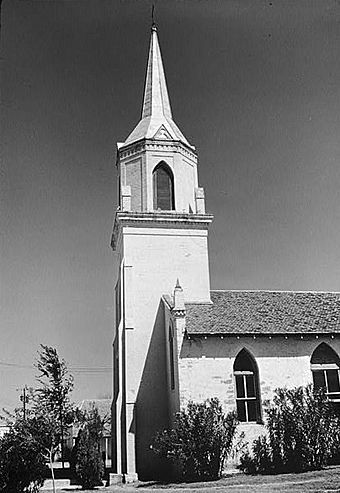Roma Historic District facts for kids
|
Roma Historic District
|
|

Tower of the Church of Our Lady of Refuge of Sinners
|
|
| Location | Properties along Estrella and Hidalgo Sts. between Garfield St. and Bravo Alley, Roma, Texas |
|---|---|
| Area | 27.5 acres (11.1 ha) |
| Architect | Heinrich (Enrique) Portscheller, John Vale |
| Architectural style | Classical Revival, Vernacular Mexican |
| NRHP reference No. | 72001371 |
Quick facts for kids Significant dates |
|
| Added to NRHP | July 31, 1972 |
| Designated NHLD | November 4, 1993 |
The Roma Historic District in Roma, Texas is a very special place. It shows us what a border town in the lower Rio Grande valley looked like many years ago. From 1829 to the 1880s, Roma was an important port. It was a key spot for moving goods across the Rio Grande river.
The buildings in Roma are similar to those in Ciudad Mier in Mexico. They also look like buildings in Guerrero Viejo upriver. Roma is famous for its buildings made from river sandstone and a type of limestone called caliche. Builders also used special molded bricks. They used unique stone-laying methods like rejoneado, which uses patterned large and small stones. Another method was sillar, where stones are laid in a smooth, even pattern. Both methods often had a rough lime plaster on the outside. This plaster was decorated with smooth, colored plaster bands, a common style in northern Mexico.
A German immigrant named Enrique (Heinrich) Portscheller brought new ideas for molded brick to Roma. He learned flat brick roofing techniques from Monterrey. He then created decorative bricks used in Roma, Mier, Rio Grande City, and Laredo. Portscheller designed buildings using his bricks. He also added beautiful wrought iron balconies. These balconies reminded people of both New Orleans and Monterrey. Most of his remaining work can still be seen in Roma today.
The historic district also includes the Roma-Ciudad Miguel Alemán International Bridge, built in 1928. This bridge is a State Antiquities Landmark. You can also see the old river wharfs and the custom house.
History of Roma
Roma was founded in 1821. At that time, it was part of a Spanish area called Nuevo Santander. The spot was a good place to cross the Rio Grande. It became known as El Paso de la Mula, meaning "Pass of the Mules." The area was important for trading salt from Roma to Monterrey.
After Mexico became independent, Roma became part of the Mexican state of Tamaulipas. But in 1835, with the creation of the Republic of Texas, Roma became part of Texas. Even after a battle at Mier during the Mexican–American War in 1848, the region stayed in Texas.
During the American Civil War, Roma became very rich. This was because of the cotton trade. Cotton was sent through Mexico to Europe. Steamboats could reach Roma until the mid-1800s. However, the river's water levels dropped because of new projects upstream. This stopped river shipping by the 1880s. Since railroads bypassed Roma, the town did not grow much. This helped to keep its old buildings and charm safe from modern changes.
What You Can See in Roma
The Roma Historic District has 38 important buildings. Sixteen of these are stone buildings from 1829 to 1870. Nineteen are brick buildings from 1880 to 1900. The district can be divided into a few main areas:
- Plaza Area: This area has an open plaza that faces the Rio Grande and Mexico. At the north end, you can see the tower of the Catholic Church. It lines up perfectly with the plaza. The lower plaza has walled areas built for important families like the Vale-Garcia, Cox, Guerra, Saenz, and Ramirez families. These areas also had businesses, especially the Guerra store, which was very important for the town's trade.
- Wharf Area: This area is along Hidalgo Street and goes up to Juarez and Estrella Streets. It was used for river trade. You can find old warehouses and stores here. The Roma-Ciudad Miguel Aleman Bridge is also in this area. It is connected to the Arroyo de San Pedro, a small stream.
- Customs House Area: This area includes Lincoln and Water Streets. It has a mix of businesses and homes, mostly made of stone. A large brick family compound at Zaragoza and Estrella streets stands out. The customs house was built on the highest point of the bluff.
- Northwestern Zone: This area is near the Arroyo de los Negros. This was where a second ferry crossing on the Rio Grande was located.
The Roma Historic District was added to the National Register of Historic Places in 1972. It was named a National Historic Landmark in 1993. Besides the international bridge, the Manuel Guerra Home and Store is also a State Antiquities Landmark. The district is also a Recorded Texas Historic Landmark (RTHL). It is listed as Early Commercial Center and includes several individual RTHLs.



